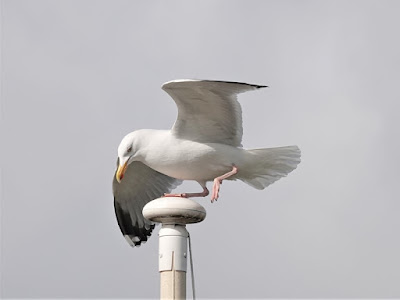I spent time on both Wednesday 22nd and Thursday 23rd March on the Wirral, mainly to watch the high Spring tides moving birds out of the salt-marsh near Parkgate. I am still working through the photos. Meanwhile on the Wednesday post high-tide I visited Hoylake as the tide receded. Here are some images from there.
As usual there were plenty of Redshanks moving out to feed on the newly expose mud. Here two pass by.
Eight together. Its easiest to count the bills.
And none here. Quite what the left-most bird is doing is hard to understand.
This one peering about!
This is not a Ruff but a Redshank with the wind behind it ruffling its neck feathers.
And on this one ruffling the tail feathers as well.
One of these two has found food. Most likely a Ragworm (Nereis diversicolor).
Look carefully: the upper bird is a Dunlin for comparison.
A trio of photos of Common Gulls of different ages. Here is an adult. Note the dark eye; the rather thin bill with a sub-terminal dark band; and the white area on the wing-tip much more extensive than on any other gull species.
Here is a second year bird with black extending along the front of the wing. It has the same dark eye and dark-marked thin bill. Note the collared effect which is most noticeable in winter.
And here is a first year bird. It shows a grey panel in the centre of the wing otherwise the markings are mainly brownish. Note again the collared effect of the markings.
Another first-year gull, in this instance a Herring Gull. The back is the only part that resembles an adult. The eye is beginning to go pale.
An adult Herring Gull attempts to land on top of a flag pole in a strong wind. Right foot down.
Oops. Left foot down and the right foot slips off.
Flap hard and try again with the right foot.
Give up and sit on a roof instead.
A Starling. The base of the bill is pink so it is a female – males have a blue base to the bill. Note the breast: in the breeding season Starlings become less spotted.
(Ed Wilson)
















